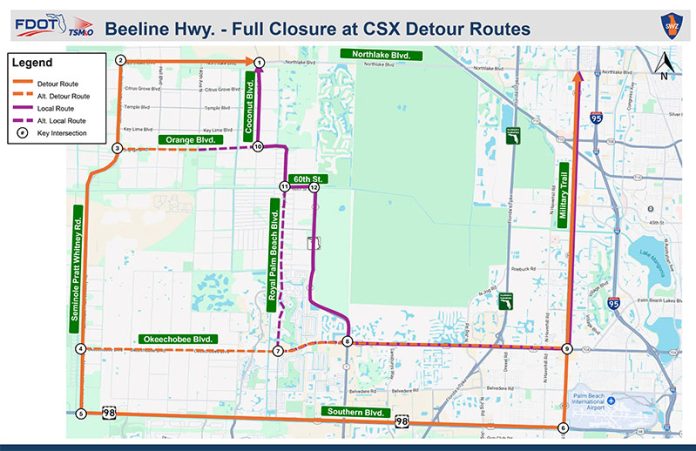As the western communities brace for a traffic tsunami caused by the complete closure of Northlake Blvd. at the Beeline Highway, the Town of Loxahatchee Groves is marshaling its forces to make sure that the planned eight-day closure does not completely swamp the rural enclave in a sea of cars.
Even before officials confirmed this week that the closure would begin Friday, Aug. 1, town officials were working with the project engineer, the Florida Department of Transportation, the Palm Beach County Sheriff’s Office, Palm Beach County Fire-Rescue and others to “get ahead of this project,” said town consultant Mary McNicholas of Sluggett & Associates at a meeting Tuesday, July 1.
McNicholas helped organize a presentation at the meeting with key project leaders. She added that she has been working with town staff on a plan ever since the closure was announced.
“It will be a generally bad situation that we’re going to have to deal with,” McNicholas said.
In an effort to stay ahead of the project, she said the town created the first written plan for maintenance of traffic, which was passed on to FDOT and the surrounding communities.
“This plan is designed to provide the best and safest procedures for our town residents, businesses and visitors,” McNicholas said, adding that the focus is on safe north-south access.
Mel Pollock of the engineering firm the Corradino Group is overseeing the entire project, which includes work from the area of Military Trail/Blue Heron near the VA Hospital, northwest to just past Northlake Blvd.
In this area, the Beeline is currently a four-lane highway with water collected in a swale system. It will become six lanes with a curb and gutter system, with water piped to outfall locations. The roadway’s footprint will be much larger, Pollock said. It will also raise the profile of the roadway and replace the bridge over Florida’s Turnpike, while adding additional capacity for the future.
Pollock explained that CSX, which operates the railway at that location, said they have had issues with that rail crossing for a number of years, and they need to do a full replacement, which will require the eight-day closure. He stressed that they will be working day and night at the intersection to get it done.
“If there is a silver lining, we will be able to get a lot of work done while working concurrently as CSX works on their full rail replacement,” Pollock said.
He added that the entire existing crossing will be removed and replaced, also necessitating the full closure rail traffic on that route. However, the end result will be a much smoother crossing for both trains and vehicles.
Pollock added that they have worked out a system with emergency vehicles that will allow emergency services to continue as needed.
There will also be signs and messages on roads and the turnpike regarding the closure.
County Engineer David Ricks was also at the meeting. He said that the county’s traffic engineers will change signal timing in an effort to keep traffic moving on the detour routes. Drones will be used for onsite surveillance.
“This will be all hands on deck,” he said, but cautioned that, “Once you get to a certain capacity, there is only so much you can do with signal timing.”
In Loxahatchee Groves, that will likely mean extra traffic on Okeechobee through the letter roads.
The official detour maps, which have been shared with online mapping software such as Google Maps, primarily direct traffic to Southern Blvd. However, Okeechobee Blvd. is considered an “alternate detour route.”
Furthermore, locals are expected to seek alternative pathways, which could be dangerous in rural areas like Loxahatchee Groves, with unpaved streets near canals without guardrails.
The focus of the PBSO will be to ensure safety and help keep traffic moving, said PBSO Lt. Darla Sauers.
She said that the PBSO’s Motor Unit and all community service aids will be reassigned to the affected area to direct traffic for the duration, particularly during rush hours.
“We ask that all residents continue to obey the laws of the roadway,” she said, asking people not to run lights or drive on the shoulder.
Above all, expect delays and plan accordingly.
McNicholas said that the town considered spending money on purchasing traffic deterrents but decided not to spend taxpayer money on things that will not be necessary over the long term.
Town traffic engineer Tricia Barr with Simmons & White praised the FDOT for being very responsive. She added that they are looking into temporary signals to create gaps to get people in and out of the letter roads.
Meanwhile, both the PBSO and drones will be monitoring the detour routes with an aim to stop through traffic from switching onto local roads.
PBCFR District Chief Amanda Vomero said that her agency will adapt to make sure that emergency services continue uninterrupted. This could mean using Trauma Hawk to move patients if roads are too congested.
“We have no choice here,” Vomero said. “This is happening. We need to go in with the right mindset and be patient with one another. Everyone will be stuck in the same traffic that you’re stuck in.”
She urged people not to create a situation that can lead to an accident.
Other county officials were on hand to note that more than 50,000 mailers will be going out to area residents with details about the situation. It was also noted that there are special hotel rates available for residents in critical industries, such as healthcare, who need to stay by their work to avoid traffic issues.
Mayor Anita Kane floated the idea of cutting trash pickup to once a week that particular week to avoid the extra stop-and-go truck traffic.
Councilman Paul Coleman thanked all the visiting officials, as well as town staff and the Sluggett team for all the work they have done to get the town as prepared as possible for the coming situation.








